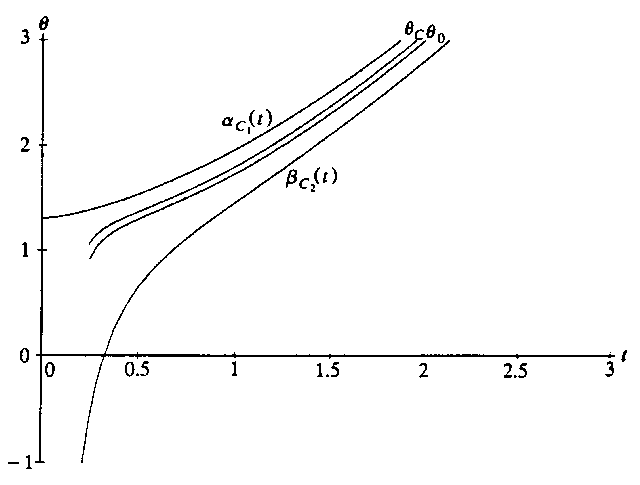![[Shownotes]](../gif/annotate/sshow-191.gif)
 , after the balancing transformation.
Theorem 4.7.5 of [4, p. 188] asserts that if
, after the balancing transformation.
Theorem 4.7.5 of [4, p. 188] asserts that if  is a
narrowing antifunnel for the differential equation
is a
narrowing antifunnel for the differential equation  , and if
there is a function
, and if
there is a function  such that
such that
 ,
in U,
and such that
,
in U,
and such that  , then there is a unique
solution remaining in U as
, then there is a unique
solution remaining in U as  .
Applied to equation (12), we find
.
Applied to equation (12), we find

 for t > 0, so with
for t > 0, so with  ,
the uniqueness criterion is satisfied. This shows that there is a unique
solution remaining in each antifunnel.
To see that any solution
,
the uniqueness criterion is satisfied. This shows that there is a unique
solution remaining in each antifunnel.
To see that any solution  of equation (12)
does stay in one of these antifunnels, let
of equation (12)
does stay in one of these antifunnels, let  and
and  be defined respectively by the properties
be defined respectively by the properties

 Conceivably
Conceivably  or
or  , but certainly
, but certainly  , and
we will be done if we can show that
, and
we will be done if we can show that  .
.
In Figure 14,
we redraw
Figure 5 using  and
and  .
If
.
If  , choose C with
, choose C with  ; the unique solution
; the unique solution
 lying in the antifunnel defined by
lying in the antifunnel defined by  and
and
 must be either above
must be either above  or beneath it, because
solutions cannot intersect. If it is above,
or beneath it, because
solutions cannot intersect. If it is above,  is also above,
contradicting the definition of
is also above,
contradicting the definition of  ; if it is beneath, then so is
; if it is beneath, then so is
 , contradiciting the definition of
, contradiciting the definition of  . Thus, every solution
is of the form
. Thus, every solution
is of the form  for some C, and there is a unique such
solution for each C.
for some C, and there is a unique such
solution for each C.


Figure 14: Fences  and
and  associated with a solution
associated with a solution  .
.
